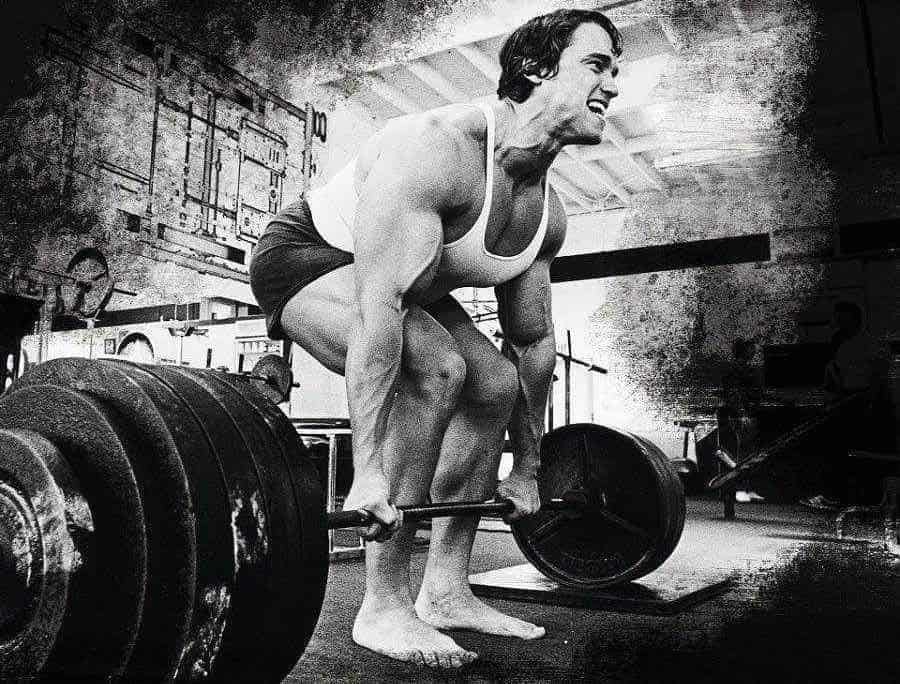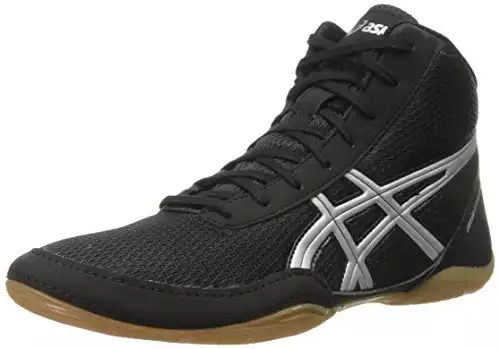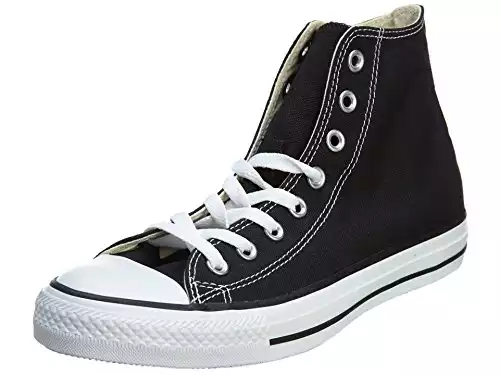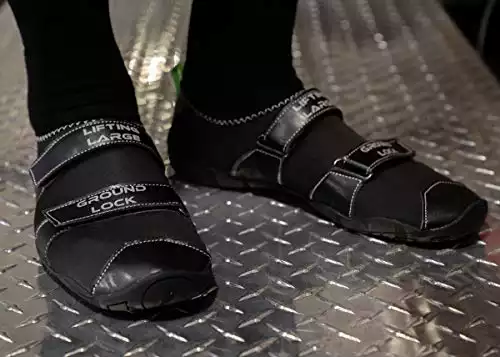Some links in this article are affiliate links, which means I earn from qualifying purchases.
The deadlift represents the art of powerlifting and strength.
While other exercises focus on endurance and bodyweight manipulation, deadlifting is straightforward: the more you lift, the better your overall fitness level.
This is why many lifters do various tweaks in their techniques to increase their leverage, even if by a little.
I remember when I saw one of my brothers deadlift barefoot. No shoes, just socks.
Is it better to deadlift barefoot? Barefoot deadlifts have anecdotal benefits. They help you engage more of your posterior chain and increase force transfer efficiently between you and the floor. Furthermore, you'll notice better balance, lower range of motion, better weight distribution, and improved feel. Overall, you'll lift more weight and progress your strength levels.
As a lifter who has seen the “gym mysticism” phenomenon come up with very stupid, inefficient ways to lift more, I understand your skepticism.
The 9 Reasons to Deadlift Barefoot are:
To get a more comprehensive idea about the topic, I will break down the pros and cons individually, giving you everything that you need to know before making your choice.
Let’s get into it!
What Is Barefoot Deadlift?
As the name suggests, deadlifting barefoot means you perform the movement without any shoes on. Some lifters also choose to not wear any socks during the deadlift.
The idea of deadlifting barefoot comes from old time Strongmen and Bodybuilders who challenged their strength levels weekly.
If you've never tried this, I suggest you do this and see if you feel a difference. You'll first notice the feedback from your feet to your back muscles.
The mind muscle connection enhances the deadlift movement and overall you "feel" the lift throughout the range of motion.
Deadlifting Barefoot vs Deadlifting In Lifting Shoes
Is there any scientific evidence behind a barefoot deadlift?
There are 2 primary studies reflecting the affect of deadlifting barefoot.
The first study published in the Journal of Strength and Conditioning Research sought to show the affect on force and power from barefoot deadlifts. The overall results were inconclusive.
But, Hammer et al. found lower rate of force development when wearing shoes compared to barefoot. This observation shows support to the idea of disconnection between the ground and the sole.
They found no significant differences in peak force or in time to peak force between the footwear conditions.
Another recent study from February 2021 by Bennett et al. sought to assess the differences between conventional and sumo deadlift in barefoot and with lifting shoe conditions.
They found barefoot deadlifting to be more efficient during the concentric phase of the movement. This is mainly due to the reduced workload and vertical displacement of the barbell.
In other words, since barefoot deadlifting involves you being closer to the ground, you have to move the barbell a shorter distance up.
The main finding that was very interesting is the didn't find any differences to performance related variables. These include force produced and force velocity. Hence, the authors suggested using barefoot deadlifts on a case by case basis and not for performance enhancement.
So why do powerlifters and strength trainees use the barefoot deadlift?
9 Reasons To Deadlift Barefoot
There are many reasons tucked into this simple change to your deadlifting routine, hence why it was used by many high-profile figures of the lifting world.
The most notable of these is Arnold Schwarzenegger.

1. Shorter Range Of Motion
This is a bit harder to grasp, but I’ll do my best to explain.
After all, it does seem quite counterintuitive. It’s the same motion, but without shoes. How does that decrease range of motion?
It has to do with the thickness of your sole. Wearing footwear implicitly means putting a barrier between your foot and the floor. This barrier also means an extra distance that you have to move the weight through.
Yes, I hear you, it may not be a lot. But 0.5-1.5 inches of added height can make a big difference in the max lifting game.
Remember, progressing in deadlifts means harnessing the most leverage that you can get.
2. Less Work And Energy Expended
Related to the above reason, since you're moving the weight a shorter distance, you're working less.
This idea relates back to high school physics and energy expenditure. Work is related to how far you move a certain weight with the same force. Since your deadlift bar is moving a shorter distance overall, your body is working less.
Less work means less energy.
Hence, these small savings in energy add up to you being able to perform more reps per sets. Alternatively, you could move heavier weight for the same number of sets and reps. With more weight, your muscles better adapt and strengthen.
3. Better Force Transfer
On this note, the sole does another thing to hurt your deadlifting performance: it absorbs force.
Think about running shoes. Running is basically a series of ‘jumps’ from one foot to the other, in regular succession, to travel a certain distance.
Walking is the same thing but at a slower pace. The impact with the ground travels up the joints, having the most effect on the knee, which becomes destabilized over time.
Thus, the goal of the runner is to reduce this force travelling up. Mainly by getting a pair of shoes that absorbs impact force and prevents it from hurting the knee. The same is done by walking, everyday shoes, but to a smaller extent.
While deadlifting, you want to achieve the opposite effect: to get as much force transfer upward as possible. Remember that this exercise is a combination of pulling the weight with your core and pushing away with your feet. Cut one of them loose and the whole thing falls apart.
While deadlifting barefoot, you eliminate any layer of the sole that can absorb force, leaving you with the bare minimum (the flesh and bone, that is) through which force can be transferred. This is why this reason also stands out for barefoot squatting.
Nevertheless, barefoot deadlifts mitigate this problem to the best of one’s ability.
4. Improved Balance
Balance is crucial to getting the most out of a deadlift.
The stiller your body is, the greater amount of force you will be able to use.
Why is this the case with barefoot deadlifting?
Because most shoes, especially running and casual sneakers, have curvature or elasticity of the sole. This your stance feel unnatural to your body.
Obviously, the body’s integrated sense of balance doesn’t handle artificial footwear very well. On the flipside, barefoot deadlifting allows for maximum ability to balance and reduce rocking. Hence, you get better leverage to lift.
5. More Engagement Of The Posterior Chain
Disclaimer: this advantage only applies to shoes that have a slightly elevated heel.
Deadlifting is a compound movement. During the exercise, not one single muscle group should be working exclusively, when you can use other groups to increase the force you generate.
With elevated heel shoes, you shift your body’s center of gravity forward, putting more pressure on the knee joints and making the quads work harder. But if you choose to go barefoot, there is no tilt that causes this.
Instead, you will see more engagement from the glutes and the inner thighs and less pressure on the quads. Is this a good thing?
All in all, yes, it is. Although you won’t develop the quads as much as you would with elevated heel shoes, we assume that your goal is to break PRs and increase max lifting.
Making the movement more compound will do this, leading to more development in the aforementioned areas and a more even ground for muscle engagement.
Overall, it’s an increase in leverage.
6. Better Sensory Feedback
Sensory input from your feet plays a big role in barefoot deadlifts.
Through direct contact with the floor, you will be able to feel pressure from the floor and any imbalances your body has.
With better feedback, you can determine the strength of your foot stance and better adjust your deadlift setup.
7. Turns Your Foot On
A huge part of a successful deadlift comes from the foot.
However, due to the common footwear in today's society, the foot is usually sleeping during deadlifts. When you deadlift barefoot, you'll notice you can feel and eventually turn your foot on.
The natural arch in the foot helps you resist flattening and produces force upward as it pushes against the ground. Again, every action produces an equal reaction. The mistake most lifters make is there foot flattens and the movement becomes inefficient. Most often, coaches and trainers recommend getting orthotics.
Instead, an active foot allows you to adopt three points of contact. This position is known as the tripod foot.
After a few iterations of barefoot deadlifting, you'll notice your foot muscles aching!
The tripod foot allows maximal force production and you'll be able to corkscrew your foot into the ground. The common tip is to make a heel print in the floor.
This is a popular cue for deadlifts and comes to the next reason for barefoot deadlifting. It all has to do with the hips.
8. Activates Hip Extensor Muscles
Deadlifts are an essential hip hinge movement.
Many lifters make a mistake of using their knee extensor muscles instead of their hips. When you wear shoes during deadlifts, you will notice your balance is slightly towards the front.
When you barefoot deadlift, your weight shifts backwards and more leverage is needed from your hips to move the weight up.
You'll notice that your outer and inner hip muscles need to produce torque directly through your feet.
9. Strengthens The Calves And Ankles
You need stability and balance to get a good deadlift.
For this reason, many people say that shoes are essential, as most of them come with some type of mechanism for stabilizing the ankle joint and the calves.
Now, I’m not saying that this is a bad thing. Ankle stabilization is crucial for many exercises. But we can do better than that in the case of deadlifts.
When you perform this exercise barefoot, you allow your ankle to move naturally, without being bound by some sort of strap.
This may be more challenging at first, but it gives you a very important opportunity:
To develop your ankle and calf strength.
This will take a while to happen properly, but remember that using straps to immobilize these joints is a quick fix and not exactly the natural development of the body. Training these muscles will pay off in the future, so it is a wise investment to make.
Once your strength develops in these areas, you will outperform anyone who did not take the time to do it.
Drawbacks To Deadlifting Barefoot
But let us not get carried away by the “too good to be true” mantra. Let’s have a look at some of the most common downsides to this technique.
1. Hygiene Concerns
If you don’t know when was the last time your gym’s floors were properly cleaned, you may want to stay away from barefoot lifting. In gyms that allow for this type of training, many people have probably done it before you.
It would be unrealistic for me to say that there shouldn’t be some concerns about catching a fungus or bacteria.
If you want to go head-first into the hygiene storm, remember to sanitize yourself and the ground properly. This applies to lifters who are exercising from home too, as you have more control over the floors in your own house.
2. Gym Rules
Partially because of the reasons listed above, many gyms choose to not allow barefoot lifting of any kind.
This generally refers to direct contact between your feet and the floor, which can be mitigated using some form of cloth, or shoes with very narrow soles.
Remember that gym rules are there to be respected, so don’t break them, or you may get an interdiction. Trust me, other lifters WILL see you doing this and they WILL complain about it.
Don’t risk it!
3. Professional Lifting And Competitions
Although training barefoot may help develop crucial aspects of your deadlift technique, you will have to get some footwear. Probably all organizations for professional lifting require you to wear something on your feet.
Of course, some of the points, such as better balance and improved ankle strength, still stand.
But many lifters say that it’s more comfortable to train in the same manner in which they will compete. This may or may not be the case for you, but it’s still a huge downside to barefoot deadlifts of any kind.
Alternatives To Barefoot Deadlifting
You may have noticed that most, if not all, the reasons listed above have something to do with a reduction in sole thickness and liberation of foot movement.
Because of this, along with the advantages of barefoot deadlifting, people have developed shoes that mimic these effects to a certain degree.
Using the following types of shoes, you will likely get the same benefits as you would by deadlifting barefoot.
But now you are eligible for gym training, participation in competitions, and you don’t have to worry about scary fungi or bacteria.
Best Shoes Similar To Barefoot Deadlifting
Top Pick: Wrestling Shoes
Wrestling shoes stand out as the top pick because of their remarkable 0mm sole, which is very close to the feeling of barefoot lifting.
Additionally, models such as the Asics Wrestling Shoes also offer a grippier underside, allowing you to be grounded into the floor better and to not slip during the deadlift.
The downside is that you still have ankle stabilizers, weaker than straps, though, that will hinder your progress with ankle strength. But, aside from this, they are a great choice.
Second Pick: Converse Shoes
Although somewhat more commercial than the wrestling shoes, Converse shoes also have a 0mm sole, which gets you as close to the floor as possible, while keeping a thin layer in check.
They are not as good as the Asics model because they lack a powerful grip, which makes you more likely to slip while deadlifting. If this is not a concern for you, then your budget may get away with some additional funds by purchasing these shoes.
Third Pick: Deadlift Slippers
Any narrow sole and flat sole works for deadlifts.
Thus, Deadlifting slippers are an option that provides the thinnest layer between your foot and the ground. Many people avoid this option, though, because they feel that it looks awkward or silly.
But, if you don’t hold looks to such high regard, or have many pals that use them, they may be your cheapest option.
Frequently Asked Questions
Why Do You Need Flat Shoes For Deadlifting?
You don’t “need” flat shoes, you can deadlift with elevated heel shoes too. But, if you aim for the largest amount of force possible, flat shoes offer the best option out of the bunch. Thick soles may absorb force, while elevated heels shift your balance too much. Flat shoes are optimal.
Is It Bad To Deadlift Barefoot
No. Most shoes designed for deadlifting try to mimic the results of barefoot deadlifting, not mitigate the “bad effects” that it has. Firms produce these shoes for the gyms that don’t allow barefoot lifting, or for lifters who want to take part in competitions. But the barefoot deadlift poses no threat to your feet health.
Should You Deadlift In Socks?
Similar to those who deadlift in slippers, they are aiming to get as close to the ground as possible. Socks are just another way of coping with gym rules or happen because of hygiene concerns. Either way, socks are just another alternative that reaps the benefits of barefoot deadlifting.
Can You Deadlift With Vans?
As long as the sole of the shoe approaches 0mm, you should be good to go. I gave the example of Converse shoes because the firm reliably produces such models. If Vans does the same and you enjoy them more, go for it!
Final Thoughts
There you have it, all the pros and cons of deadlifting barefoot, along with some nifty alternatives to serve as a midway point.
All in all, it may be a smart decision to deadlift barefoot if you’re aiming for personal strength and progression with heavy weights. Even for those of you aiming to compete in professional contests, there are options to serve as replacements, almost as good as barefoot.
That being said, make up your mind and choose for yourself when it comes to barefoot deadlifts. Although deadlifting barefoot vs deadlifting with lifting shoes will always be of debate, you can choose based on your training needs. That is always the best option.
References
Hammer M.E., Meir R.A., Whitting J.W., Crowley-McHattan Z.J. Shod vs. Barefoot Effects on Force and Power Development during a Conventional Deadlift. J. Strength Cond. Res. 2018;32:1525–1530. doi: 10.1519/JSC.0000000000002246.
Valenzuela K.A., Walters K.A., Avila E.L., Camacho E.L., Alvarado F. Footwear Affects Conventional and Sumo Deadlift Performance. Sports (Basel). 2021 Feb; 9(2): 27. Published online 2021 Feb 11. doi: 10.3390/sports9020027
La Marche J. Unpublished Master’s Thesis. Iowa State University; Ames, Iowa, USA: 2019. Biomechanical Effects of Shod vs. Unshod Deadlift in Males, Iowa State University Digital Repository.








